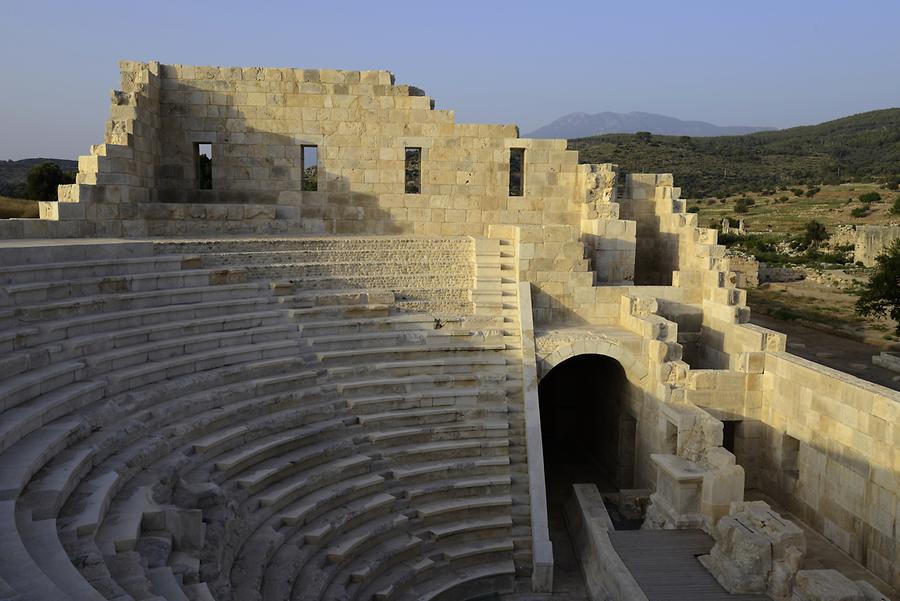Patara - Bouleuterion (Assembly House)#

Patara - Bouleuterion (Assembly House), September 2015, © Gerhard Huber, under CC BY-NC 4.0 +Edu
The rocky coast of ancient Lycia stretches west of Antalya and Kemer
Kemer, Turkey
. Since no large hotel complexes were built here, the varied region could preserve much of its original charm. The Lycians, a people of its own culture, writing and language, have been settling here for at least 4000 years and have been known for their monumental tombs since antiquity. However, the influences of Greek culture did not spare the Lycians. They carefully took over the philosophy of their colonial rulers as well as the regime of the city-states, but without losing their own cultural identity. During the Hellenistic period, the region flourished thanks to a lucrative maritime trade and a profitable agriculture. Cereals, olives, wine and livestock laid the foundation of prosperity. However, the big boom did not come until the Lycian cities merged into the 'Lycian League' 2200 years ago. This union was to enter the history books as the perfect example of a federal-democratic organization. It looks amazingly modern. Each polis sent a specific number of deputies, depending on their population, to a supraregional parliament, which annually elected a head of state, a treasurer, a federal secretary, and a military commander. It appointed joint courts to deal with disputes between the city-states and to ensure that all members remained faithful to the constitution. For at least 700 years, until well into Roman times, the confederation secured the prosperity of the region. However, between the 11th and 13th centuries, waves of immigration of Islamic Turkic peoples from the east brought an end to this unique culture. Soon, only shepherd nomads roamed the country. Mother Nature regained the landscape - a piece of luck for archaeologists, because many ruined cities remained well preserved.
Westlich von Antalya und Kemer
Kemer, Turkey
erstreckt sich die felsige Küste des antiken Lykien. Da keinerlei große Hotelanlagen existieren, konnte sich die abwechslungsreiche Region noch viel von ihrem ursprünglichen Charme bewahren. Seit mindestens 4000 Jahren siedeln hier die Lykier, ein Volk mit eigener Kultur, Schrift und Sprache und schon in der Antike bekannt für ihre monumentalen Grabbauten. Die Einflüsse der griechischen Kultur machten jedoch auch vor den Lykiern nicht halt. Sie übernahmen vorsichtig das Weltbild der Kolonisten ebenso wie das Regierungssystem der Stadtstaaten, ohne dabei jedoch ihre kulturelle Identität zu verlieren. In hellenistischer Zeit erreichte die Region ihre höchste Blüte, dank eines einträglichen Seehandels und einer ertragreichen Landwirtschaft. Getreide, Oliven, Wein und Viehzucht legten die Basis des Wohlstandes. Die große Boom kam allerdings erst, als sich die lykischen Städte vor 2200 Jahren zum 'Lykischen Bund' zusammenschlossen. Diese Union sollte als Musterbeispiel einer föderal-demokratischen Organisation in die Geschichtsbücher eingehen. Sie wirkt verblüffend modern. Jede Polis entsandte je nach Einwohnerzahl Abgeordnete in ein überregionales Parlament, das jedes Jahr ein Staatsoberhaupt, einen Schatzmeister, einen Bundessekretär und einen Militärkommandanten wählte. Es setzte gemeinsame Gerichtshöfe ein, die sich um Streitigkeiten zwischen den Stadtstaaten kümmerten und darauf achteten, dass alle Mitglieder der Verfassung treu blieben. Mindestens 700 Jahre lang, bis weit in die Römerzeit, sicherte der Bund den Wohlstand der Region. Zwischen dem 11. und 13. Jahrhundert setzten jedoch Einwanderungswellen islamischer Turkvölker aus dem Osten der einzigartigen Kultur ein Ende. Schon bald zogen nur noch Hirtennomaden durch das Land. Die Natur holte sich die Landschaft zurück – für Archäologen ein Glücksfall, denn so blieben viele Ruinenstädte gut erhalten.